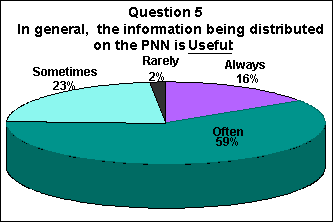
Jane M. Thomas, Pesticide Notification Network Coordinator, WSU
Pesticide Notification Network (PNN) users scored the network highly in all categories, according to results received recently from the 1997 PNN Users Survey. The survey, distributed in mid-December, was designed to gauge what types of information distributed by the PNN were most useful, to determine whether users were satisfied with the service, to see if users wanted changes in the types of information they receive, and to assess the system's overall usefulness. The timing of the survey allowed users to respond after experiencing a full year's worth of regulatory activity.
All those who receive information from the PNN received surveys. The contact list is predominantly composed of people from two groups: Commodity/Commission representatives (69%) and WSU Cooperative Extension personnel (31%). There was an overall 47% response to the survey, roughly representative of each of the two groups.
The initial question asked PNN users to rate 10 categories of PNN notifications they receive. The results, summarized below, ranged from an average of 4.6 for new product registrations, to 3.3 for 2ee use recommendations. Even the least valued type of notification received a fairly high score.

The next three questions asked PNN users to comment on the level of detail contained in the notifications, their timeliness, and the quantity of information received from the PNN. Overall, 66% of users reported that the level of detail in the PNN notifications was adequate. Thirteen percent of users responded that the level of detail was less than adequate.
 A total of 89% of those surveyed responded that information
received from the PNN was timely enough to be useful "always"
or "often", and nearly all of the respondents stated that the
amount of information received was "manageable.
A total of 89% of those surveyed responded that information
received from the PNN was timely enough to be useful "always"
or "often", and nearly all of the respondents stated that the
amount of information received was "manageable.
Several questions were included in the survey to determine if changes should be made regarding the type of information distributed on the PNN. First, users were informed that notifications had not been distributed when SLN revisions only altered waste disposal, spray drift precautions, or pollinator protection statements. When asked if the PNN should be distributing notifications SLNregarding all revisions, 70% of the respondents replied that this was unnecessary. There was some disagreement between PNN user groups: The "no" response from the Commodity/Commission representatives was 85%, but it was much lower from WSU Cooperative Extension personnel (56%).
 PNN users were also informed that notifications were not
being sent if pesticide label changes only related to either pest or tank
mix information. Many of the respondents (67%) stated that notifications
should be sent when pest information was revised on a label, while fewer
than half (45%) were in favor of notifications covering changes to tank
mix information. In response to this reply, the PNN will begin distributing
notifications when label changes are made that involve pest information.
PNN users were also informed that notifications were not
being sent if pesticide label changes only related to either pest or tank
mix information. Many of the respondents (67%) stated that notifications
should be sent when pest information was revised on a label, while fewer
than half (45%) were in favor of notifications covering changes to tank
mix information. In response to this reply, the PNN will begin distributing
notifications when label changes are made that involve pest information.
The response was divided when users were informed that the PNN had not
been sending notifications when supplemental labels were revised. Users
were asked if this practice should change. Response to this question was
considered insufficient to warrant changing present practice. Similarly,
PNN operations with respect to tank  mix information
and SLN revisions will also remain unchanged.
mix information
and SLN revisions will also remain unchanged.
Finally, users were asked to provide a word to complete the following statement: "In general, the information being distributed on the PNN is useful" The results shown on the attached chart indicate that 75% of the respondents chose "always" or "often". Again, some disparity existed between groups. Of the Commodity/Commission representatives, 42% responded with "often" and 33% with "sometimes". Seventy-six percent of WSU Extension personnel responded with "often", while 18% responded with "sometimes".

Survey respondents were also encouraged to provide any comments they had about the system. Most comments were favorable. For questions or comments related to the PNN, contact Jane M. Thomas at (509) 372-7493 or jmthomas@tricity.wsu.edu.
Return to Table of Contents for the May 1998 issue